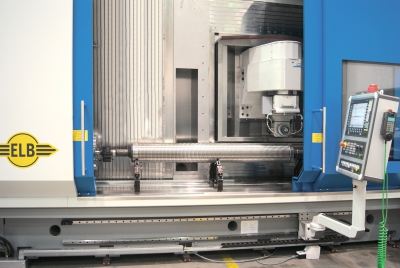
The BG series machines are equipped with a moving table or traveling column, depending on the workpiece, and are designed for grinding complex and large tools such as broaches. Depending on machine size, the components have lengths ranging from 1,000 mm at a workpiece diameter of 10-200 mm up to a maximum workpiece length of 3,000 mm and a diameter of 600 mm. The BG can grind both straight toothed and helical tools.
“The traveling column technology enables – particularly for very large and heavy components – high machine dynamics and maximum precision,” says Dr. Marcus Stanik, stating one of the main advantages. Linear motors are used in the X-axis here, enabling high axis acceleration while working almost without any wear, which ultimately reduces maintenance costs. “We can still ensure high accuracy after years of use, something our users really appreciate,” says Elb-Schliff managing director Dr. Stanik.
To reduce non-productive time, even large travel distances can be bridged rapidly thanks to the high axis speeds. According to the manufacturer Elb-Schliff, the axis dynamics is exceptional for a machine of this size, enabling very dynamic and thus accurate simultaneous interpolation of several machine axes. The motor spindles are designed for high performance with up ratings to 48 kW. The standard version comes with a high-precision indexer and tailstock, while a special steady rest can be ordered for long, slender components.
The modular machine concept also facilitates the simple and quick changeover from round tools to flat tools. The machines are designed for profile grinding as well as sharpening and equipped with an integrated measuring unit. And to make things easy for the machine operator, Elb-Schliff delivers the BG series with an extensive technology package: machine, software and technical expertise. “We support users in their entire process and offer them a complete tool production solution,” adds Dr. Stanik.
Related Glossary Terms
- flat ( screw flat)
flat ( screw flat)
Flat surface machined into the shank of a cutting tool for enhanced holding of the tool.
- grinding
grinding
Machining operation in which material is removed from the workpiece by a powered abrasive wheel, stone, belt, paste, sheet, compound, slurry, etc. Takes various forms: surface grinding (creates flat and/or squared surfaces); cylindrical grinding (for external cylindrical and tapered shapes, fillets, undercuts, etc.); centerless grinding; chamfering; thread and form grinding; tool and cutter grinding; offhand grinding; lapping and polishing (grinding with extremely fine grits to create ultrasmooth surfaces); honing; and disc grinding.
- interpolation
interpolation
Process of generating a sufficient number of positioning commands for the servomotors driving the machine tool so the path of the tool closely approximates the ideal path. See CNC, computer numerical control; NC, numerical control.
- steady rest
steady rest
Supports long, thin or flexible work being turned on a lathe. Mounts on the bed’s ways and, unlike a follower rest, remains at the point where mounted. See follower rest.








